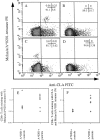High frequency of skin-homing melanocyte-specific cytotoxic T lymphocytes in autoimmune vitiligo
- PMID: 9743539
- PMCID: PMC2212532
- DOI: 10.1084/jem.188.6.1203
High frequency of skin-homing melanocyte-specific cytotoxic T lymphocytes in autoimmune vitiligo
Abstract
Vitiligo is an autoimmune condition characterized by loss of epidermal melanocytes. Using tetrameric complexes of human histocompatibility leukocyte antigen (HLA) class I to identify antigen-specific T cells ex vivo, we observed high frequencies of circulating MelanA-specific, A*0201-restricted cytotoxic T lymphocytes (A2-MelanA tetramer+ CTLs) in seven of nine HLA-A*0201-positive individuals with vitiligo. Isolated A2-MelanA tetramer+ CTLs were able to lyse A*0201-matched melanoma cells in vitro and their frequency ex vivo correlated with extent of disease. In contrast, no A2-MelanA tetramer+ CTL could be identified ex vivo in all four A*0201-negative vitiligo patients or five of six A*0201-positive asymptomatic controls. Finally, we observed that the A2-MelanA tetramer+ CTLs isolated from vitiligo patients expressed high levels of the skin homing receptor, cutaneous lymphocyte-associated antigen, which was absent from the CTLs seen in the single A*0201-positive normal control. These data are consistent with a role of skin-homing autoreactive melanocyte-specific CTLs in causing the destruction of melanocytes seen in autoimmune vitiligo. Lack of homing receptors on the surface of autoreactive CTLs could be a mechanism to control peripheral tolerance in vivo.
Figures



References
-
- Song YH, Connor E, Li Y, Zorovich B, Balducci P, Maclaren N. The role of tyrosinase in autoimmune vitiligo. Lancet. 1994;344:1049–1052. - PubMed
-
- Merimsky O, Shoenfeld Y, Baharav E, Altomonte M, Chaitchik S, Maio M, Ferrone S, Fishman P. Melanoma-associated hypopigmentation: where are the antibodies? . Am J Clin Oncol. 1996;19:613–618. - PubMed
MeSH terms
Substances
LinkOut - more resources
Full Text Sources
Other Literature Sources
Medical
Research Materials

